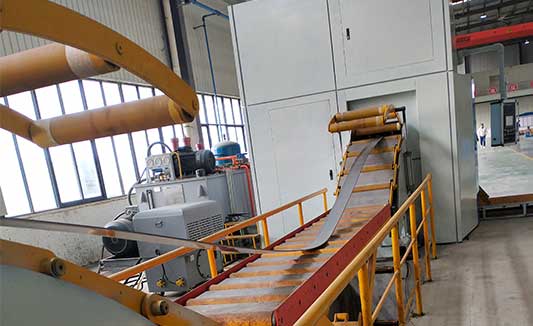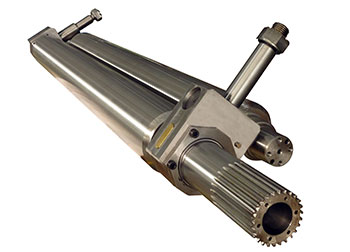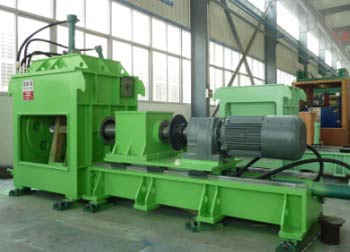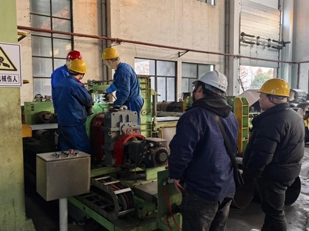Basic Requirements and Type Introduction of the Flying Shear Machine
The flying shear machine is an important device responsible for cutting in the flying cutting line. The flying shear machine can be divided into hyperbolic crank rotation and single crank rotation.
The flying shear machine is a type of shearing machine used for transverse cutting of moving rolled products. It is mainly used for cutting medium and small steel billets, thin slab billets, small section steel (bar), and hot rolled and cold rolled strip steel (including coated steel). It is also used to chop off the edges of discs cut by shearing machines (i.e. edge crushers).
Basic requirements for flying shear
As the characteristic of flying shear machine is that it can transversely cut moving rolled products, fixed length flying shear machines should ensure good cutting quality, accurate cutting length, neat cut surface, wide range of fixed length adjustment, and certain cutting speed. Therefore, the structure and performance of the flying shear must meet some basic requirements during the cutting process:
It must be able to cut moving rolled products, and the quality of the cutting section must meet the relevant national standards. That is, the flying shear machine should have a rational cutting mechanism.
It must be able to cut rolled products into predetermined lengths and can cut various fixed lengths on the same flying shear machine, with size tolerances meeting the provisions of national standards (for head cutters, it is required to accurately cut in the specified position). This requires the flying shear machine to have an accurate length adjustment mechanism.
It must meet the production requirements of the rolling mill or production line.
The speed of the flying shear must be adapted to the speed of the rolled product to ensure the quality of the rolled product and prevent equipment accidents. The use of a hydraulic roller leveler not only improves material flatness but also provides more stable support during high-speed cutting, further enhancing equipment safety and efficiency.

Types of the flying shear machine
Based on the basic requirements and working characteristics of the flying shear machine, flying shear machine generally consists of a cutting mechanism, an adjustment cutting length mechanism, a cutting edge gap adjustment mechanism, and a transmission mechanism. There are many types of flying shears used in production.
According to the part of the rolling product cut by the flying shear machine, it can be divided into head cutter and fixed length flying shear.
According to the temperature of the rolled product being cut, the flying shear can be divided into hot cutting and cold cutting.
According to the relative positions of the two blades, there are parallel blades, oblique blades, and disc blades.
According to the structure form and blade movement mode of the flying shear, there are many categories, and with the development of modern high-speed rolling mills, new types of flying shears are constantly emerging. The widely used ones are: disc flying shear machine, drum flying shear, crank rotation flying shear, swing flying shear, horizontal flying shear, etc.
Flying Shear Vs Crank Shear: Which Is Better for Purchasing?
1. Material properties determine the choice:
If you need to shear high hardness/thick plates (>8mm) and have strict precision requirements (±0.1mm), choose crank shear; if the production line is mainly thin plates (<6mm) and high-speed continuous production, flying shears are better.
2. Production line speed matching:
Flying shears can dynamically synchronize high-speed production lines (100m/min+) to avoid downtime; crank shears are suitable for **low speed (<30m/min)** or intermittent production, but the shearing force is more stable.
3. Long-term cost comparison:
Flying shears have high initial investment (servo system), but low energy consumption and fast production change; crank shears have low procurement costs, but high energy consumption and high maintenance frequency, and require a comprehensive 5-year TCO evaluation.
BOYA company, starting from the development of ball cage couplings, is committed to producing core components of significant equipment in the metallurgical industry and providing various precision equipment for various production lines. It is a unique manufacturer of metallurgical equipment and the most valuable solution provider. Welcome to consult us online!
Topics You May Be Interested in:
Roll Coating Process
Backup Rolls
Precision Blanking
Conventional Stamping
Rubber Roller Coating Machine
Press Blanking
Popular BOYA Flat Metal Processing Machinery
Other Articles about BOYA Flat Metal Processing Machinery

 English
English 





